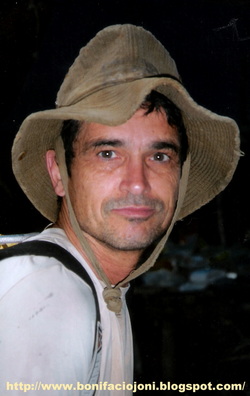- Home
- About
- Adventures
- Shop
- Events
- Upcoming
- Previous
- 15th Extreme Caving 2019
- 13TH JIABONG CAVING EXPLORATION 2019
- 16TH SPELUNKING IN CALBIGA CAVES 2018
- 13TH JIABONG CAVING EXPLORATION 2018
- 14TH EXTREME CAVING 2018
- 15TH SPELUNKING IN CALBIGA CAVES 2017
- 12th Jiabong Caving Exploration 2017
- 13th Extreme Caving 2017
- 2nd Canyoning in Biliran 2017
- 1st Canyoning in Biliran 2016
- Gallery
- Blog
- Contact
SAMAR ISLAND CAVE KINGDOM
PHOTO BY: JEAN-PAUL SOUNIER

CANYAWA CAVING EXPEDITIONS 2002
CALBIGA,SAMAR PHILIPPINES
MARCH 16, 2002 TO APRIL 20, 2002 CAVING EXPEDITION TEAM: 1.Jean-Paul Sounier (leader and photographer/French Caver)
2.Philippe Audra (karst specialist/French Caver)
3.Paul Courbon (surveyor/French Caver)
4.David Hiou You (equipment coordinator/French Caver)
5.Catherine Caullier (French Caver)
6.Christine Le Roch (French Caver)
7.Laurent Jovet (French Caver)
8.Philippe Hache (French Caver)
9.William Michel (French Caver)
10.Luc Ruyssens (French Caver)
11.Joni Bonifacio (Trexplore/Filipino Caver)
CALBIGA,SAMAR PHILIPPINES
MARCH 16, 2002 TO APRIL 20, 2002 CAVING EXPEDITION TEAM: 1.Jean-Paul Sounier (leader and photographer/French Caver)
2.Philippe Audra (karst specialist/French Caver)
3.Paul Courbon (surveyor/French Caver)
4.David Hiou You (equipment coordinator/French Caver)
5.Catherine Caullier (French Caver)
6.Christine Le Roch (French Caver)
7.Laurent Jovet (French Caver)
8.Philippe Hache (French Caver)
9.William Michel (French Caver)
10.Luc Ruyssens (French Caver)
11.Joni Bonifacio (Trexplore/Filipino Caver)
CANYAWA CAVE EXPEIDTION 2002 ” DEVILS CAVE”
 A YEAR AGO, French caver Jean-Paul Sounier and a ragtag team of explorers quietly slipped into the country on a lonely journey where only daredevils go: deep into the bowels of the earth, in the company of abysmal bats prowling in the darkest chambers. Their mission? To explore a cave system that might be Southeast Asia’s biggest ever in the heart of storm battered Samar.
A YEAR AGO, French caver Jean-Paul Sounier and a ragtag team of explorers quietly slipped into the country on a lonely journey where only daredevils go: deep into the bowels of the earth, in the company of abysmal bats prowling in the darkest chambers. Their mission? To explore a cave system that might be Southeast Asia’s biggest ever in the heart of storm battered Samar.It was not their first expedition to the rugged terrain where poverty stalks like the notorious phantoms of its fabled mountains. In year 2000 between January 30 and March 25 Jean-Paul first favorable into Samar’s lost caves together with countrymen Tristan Despaigne. Arnaud Guyot, Monika Kolowska, Christian Tamisier and William Michel.The results were quite staggering: 11,761 meters of galleries in five caves, with two found in the Suribao karst (east of Samar), and 10,251 meters in the Calbiga karst (west of Samar) inside the huge kanyawa cave where the main explorations took place. The total is way beyond the 900-sqaure kilometer surface estimate done by Italian cavers previously then considered the largest in the Philippines.Needless to say, it marked the beginning of a new era of cave discoveries in this side of the globe, and is now making its bid for recognition as the biggest ever in the Philippines, if not the Asian world.
The general surface features are a mixture of tropical pinnacle and cockpit karst. Alternate pitons and dolines form a distorted façade, which is covered by rainforest except in very steep portions deforested by people. Despite the distortion, few paths enable people to cross the platean in a cast-west direction.Yet it is only 10 percent, or so the French would like to believe. There is much left to be explored the reason why Jean-Paul. 51, decided to come back this time in the company of geography professor Philippe Audra 48 cave guide Laurent Jovet 35 military employee Catherine Caullier 45; survivor Paul Caurbon, 66; environmentalist Christine Le Roch, 38; fireman Luc Ruyssen, 54; cave guide David Hiou-You, 28; agriculturist Philippine Hache, 43; and the ruggedly handsome William, 35, the only other returnee cave guide who also sprints his ways in the rapid, rough-and-tumble world of kayaking, rafting, and other power sports. Local caver Joni Bonifacio 24; founder of Trexplore cave guiding company based in Catbalogan, accompanied the French nationals.
The French “discovered” the caves not so long ago. During the Elf Authentic Adventure 1999 classic (beamed to the outside world via cable TV) three years ago, in the limestone area located east of Kaamlongan barrio, Jean-Paul noticed the huge flow rate of Calbiga river from two kilometers downstream its spring. On the east side of the six-kilometer wide limestone plateau, he waded through two streams and saw that they disappear under the mountains. It was enough for him to theorize about a possible connections between the two tributaries and the Calbiga river; six kilometer westwards, Virgin of exploration Jean-Paul decided to set up an expedition to track down the trail of the main river which sinks on the east side of the limestone mountains, as well as to explore resurgences located on the lower part of the Suribao river in the east, which cuts its way through a small limestone area. (more…)
